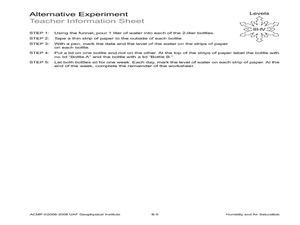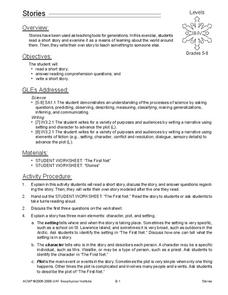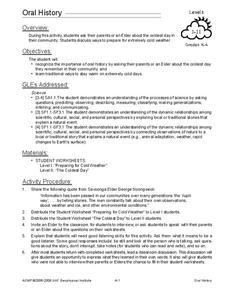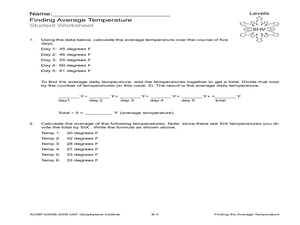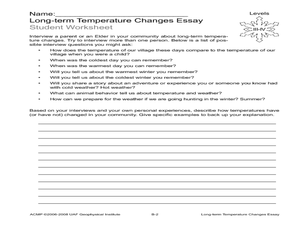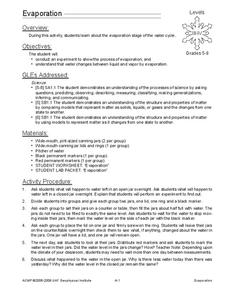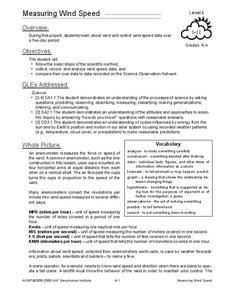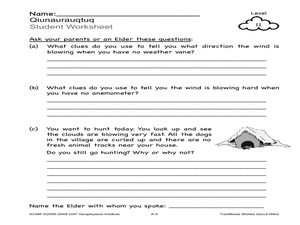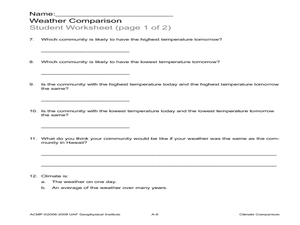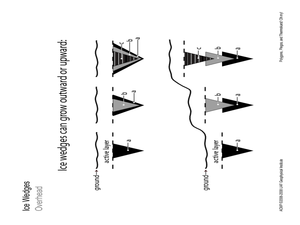Curated OER
Snowfall
Students examine the differences between snow and rain. In this precipitation lesson, students measure one inch of rain and snow to calculate the amount of liquid water. Students use a snowfall "conversion" chart to measure how much...
Curated OER
Humidity and Air Saturation
Young scholars experiment with air saturation. In this earth science lesson, students first complete an activity which teaches humidity. Then they use the scientific method to create their own experiments to test how long it takes a...
Curated OER
Seasons
Students name the 4 seasons, discussing the weather, plant life, animal life and and activities of each. Students read the book titled, "Hello Arctic," and and discuss changes in seasons that accompany the story. Students complete...
Curated OER
Weather
Students explore the weather and how it affects different seasons and activities. In this weather lesson plan, students discuss how the weather differs in each season, interview an Elder about how weather effects their activities, and...
Curated OER
Subsistence Calendar
Students create a subsistence calendar for seasonal activities in their community. In this seasonal activities lesson plan, students research the four seasons in their community and write down the activities to do in that season.
Curated OER
Stories
Students read and write a short story. In this short story lesson plan, students read a short story and answer comprehension questions on it that teaches them about the world around them. Then they write a short story to teach something...
Curated OER
Build a Thermometer
Students build a thermometer. In this weather lesson, students use red food coloring, rubber stoppers, and hard plastic tubing to build a thermometer. Students use their homemade thermometer to measure the temperature.
Curated OER
Oral History
Students interview a Native Elder to learn about oral history and cold weather. In this weather lesson, students ask an Elder about the coldest day they remember in their community and complete two worksheets for the topic.
Curated OER
Finding the Average Temperature
Students calculate averages. In this average temperature instructional activity, students collect data and use their problem solving skills to calculate average temperatures.
Curated OER
Long Term Temperature Changes Essay
Students interview Elders in their community about how temperature changes have affected their lives. In this temperature change lesson plan, students interview the Elders about the societal and environmental changes that have occurred...
Curated OER
Go Glacier Go!
Students create a model of a glacier and observe how it moves. In this landforms lesson, students learn what a glacier is, build a model glacier and observe how it moves in a manner that more closely resembles a liquid than a solid.
Curated OER
Evaporation
Students study the evaporation stage of the water cycle. For this water cycle lesson, students participate in an experiment to study the process of evaporation that uses jars and water. Students complete an observation worksheet for the...
Curated OER
Build a Weather Vane
Learners construct a weather vane using their knowledge of some geometric shapes. For this weather lesson, students work in pairs to create a weather vane in order to measure wind direction. Learners follow precise directions to ensure...
Curated OER
Finding Wind Direction
Students identify the wind direction. In this weather lesson plan, students use a weather vane to find the wind direction. Students complete a worksheet.
Curated OER
Build an Anemometer
Students investigate wind speed. For this wind instrument lesson, students build an anemometer to measure wind speed and discuss the importance of wind speed knowledge in various professions.
Curated OER
Measuring Wind Speed
Young scholars study wind speed and collect wind speed data. In this wind speed lesson, students visit a website to learn about the local wind speed forecast for their week. Young scholars discuss wind and wind speed. Students collect...
Curated OER
Traditional Stories about Wind
Young scholars observe and talk about wind using no weather instruments. In this wind lesson plan, students use their senses to observe wind. They also interview an Elder about wind.
Curated OER
Wind
Students build an anemometer and measure wind speed. In this wind speed lesson, students build an anemometer using the student instruction sheet. Students visit the Alaska windspeed website and look up the wind speed forecast. Students...
Curated OER
Name that Wind
Students study wind and the direction terms related to wind. In this meteorology lesson, students learn about the wind directions by completing a wind direction activity where kids locate cones marked with the specific wind directions....
Curated OER
Project Jukebox
Students analyze an interview with the Climate Change Project Jukebox in order to help them undertand how to use a concept map. In this writing and climate change lesson, pairs of students log onto the Internet site for Climate Change...
Curated OER
Climate Comparison
Students explore climate regions. In this climate lesson, students examine the climate regions of Alaska as well as the state of Hawaii. Students research selected Internet sources to gather information regarding the climates present in...
Curated OER
Worming Your Way Through the Soil
Students study soil, living and non-living particles in the soil, and learn about composting. In this soil study lesson, students study soil samples and discuss the living and non-living components of the soil. Students classify the...
Curated OER
Polygons, Pingos, and Themokarst! Oh MY!
Students complete activities to learn about the common land features in Alaska. In this land study lesson, students study an overhead for permafrost features. Students define ice wedge polygons, thermokarst, and pingos. Students also...
Curated OER
Permafrost
Students use a thermometer to analyze soil temperature data to determine which soil sample is normal, and which one is permafrost. In this permafrost lesson plan, students participate in a hands on activity where they identify the active...



